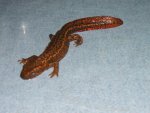Niels D
Well-known member
- Joined
- Jun 2, 2011
- Messages
- 1,339
- Reaction score
- 115
- Points
- 63
- Location
- A little village called Terheijden
- Country
- Netherlands
I don't know it this kind of conclusions can be made out of the results I got with pond water. L. laoensis live in lotic system, but other "lotic" animals have proven to be resistant to a setup with a higher germ load. Gammarus can take a high germ load, but is vulnerable to all kinds of polution. I do believe that my pond water has a high germ load, but probably a balanced one.
Why I've managed to use Daphnia as a food item can depend on a lot of reasons, but one thing is for sure in my opinion. Remove dead Daphnia asap and only introduce it to a balanced setup so the Daphnia stays alive for a longer period. Please keep in mind, although I think that you do, that this method is extremely situation based and that trying to copy it may be impossible if resourses (like similar pond water) aren't available.
Why I've managed to use Daphnia as a food item can depend on a lot of reasons, but one thing is for sure in my opinion. Remove dead Daphnia asap and only introduce it to a balanced setup so the Daphnia stays alive for a longer period. Please keep in mind, although I think that you do, that this method is extremely situation based and that trying to copy it may be impossible if resourses (like similar pond water) aren't available.





